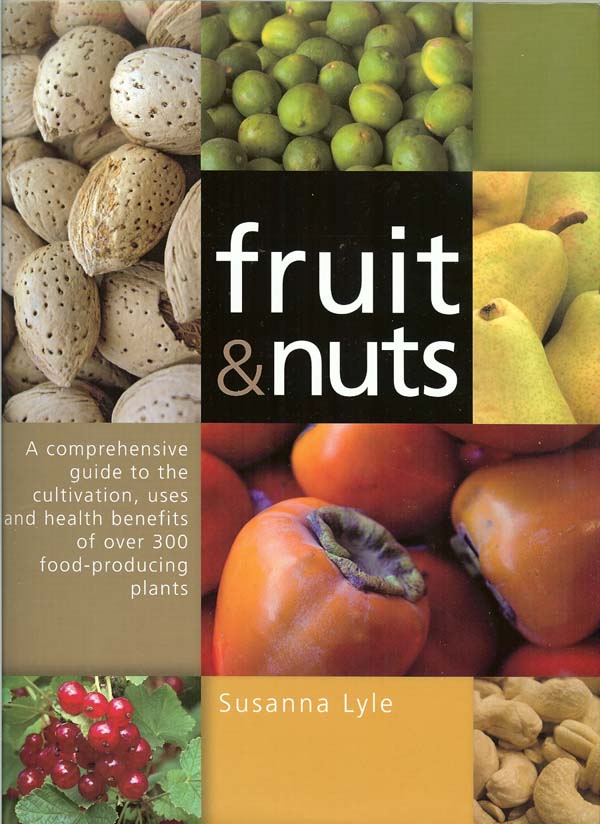|
Read 12923552 times
Connect me to:
|
Fruits & Nutsby: Susanne Lyle
Portland OR:
Timber Press 2006, $59.95, Hardbound
ISBN: 978-0-88192-759-7
Reviewed by: Jacqueline M. Newman
Winter Volume: 2006 Issue: 13(4) page(s): 26 and 27
 Subtitled: A comprehensive guide to the cultivation, use, and health benefits of food-producing plants, this A to Z guide discusses more than three hundred of them and is of value to all with interests in food. One does not need to be a horticulturalist, food historian, reporter, health expert, the curious, and those who cook will find it of value. It is a most comprehensive volume about these two food groups. More than forty pages precede the individual fruit/nut items; the Appendix of plants for different conditions and uses, the Glossary, Bibliography, and the Index, follow them. Subtitled: A comprehensive guide to the cultivation, use, and health benefits of food-producing plants, this A to Z guide discusses more than three hundred of them and is of value to all with interests in food. One does not need to be a horticulturalist, food historian, reporter, health expert, the curious, and those who cook will find it of value. It is a most comprehensive volume about these two food groups. More than forty pages precede the individual fruit/nut items; the Appendix of plants for different conditions and uses, the Glossary, Bibliography, and the Index, follow them.
The book starts, after Preface and Acknowledgments, with an Index of Common names, a chart of plant families, species, and general plant names. Pollination, structure, and beyond are next, then types of fruits and nuts, structure, plant types, cultivation, culture, propagation, yields, pruning and training, pests and diseases, and health benefits follow. Alphabetical order by botanical name, each fruit and nut has a brief history, a detailed description, and a color photograph. There is knowledgeable information about harvest and cultivation, uses as food and things nutritional/medicinal, ornamental, etc., and something about other species. Detailed information about so many different fruits and nuts, excellent pictures, common names, and variation of each, makes this a bible for wanting to be a cognoscenti whose knowledge about a specific fruit or nut needs expansion. Included is a two-page table giving health benefits with recommendations for ten health conditions. There is another table of those good for hedging, groundcover, windbreaks, vines, autumn color, and/or showy flowers. We have already used the three-page three-column one-hundred-eight item glossary, the extensive bibliography, references by common name or country, and the three-page four-column cross-referenced index on several occasions. Chinese items are not omitted, included are goujizi berries (their spelling) and Buddha’s hand, among other Asian foods. Even with all this information, some items can be difficult to locate if one does not know the botanical name. When a second edition is on the horizon, a better cross-referenced index would be of additional value. One example of this is the Goji berries, Lycium barbarum, also known as wolfberries. Another is Buddha's hand, botanically known as Citrus Medica, and yet by other names. Nothing is perfect, nonetheless, this volume is of great value and we are pleased to have it at our fingertips.
|

 Subtitled: A comprehensive guide to the cultivation, use, and health benefits of food-producing plants, this A to Z guide discusses more than three hundred of them and is of value to all with interests in food. One does not need to be a horticulturalist, food historian, reporter, health expert, the curious, and those who cook will find it of value. It is a most comprehensive volume about these two food groups. More than forty pages precede the individual fruit/nut items; the Appendix of plants for different conditions and uses, the Glossary, Bibliography, and the Index, follow them.
Subtitled: A comprehensive guide to the cultivation, use, and health benefits of food-producing plants, this A to Z guide discusses more than three hundred of them and is of value to all with interests in food. One does not need to be a horticulturalist, food historian, reporter, health expert, the curious, and those who cook will find it of value. It is a most comprehensive volume about these two food groups. More than forty pages precede the individual fruit/nut items; the Appendix of plants for different conditions and uses, the Glossary, Bibliography, and the Index, follow them.